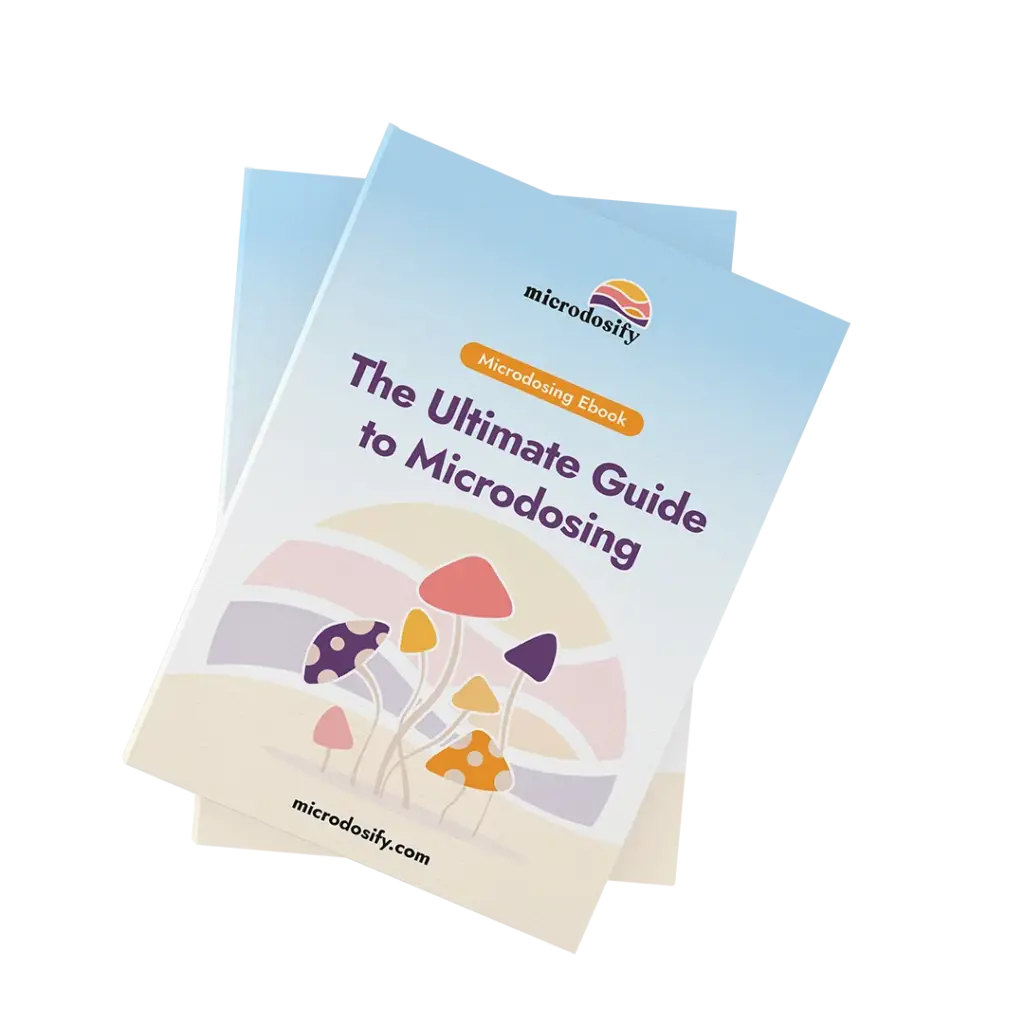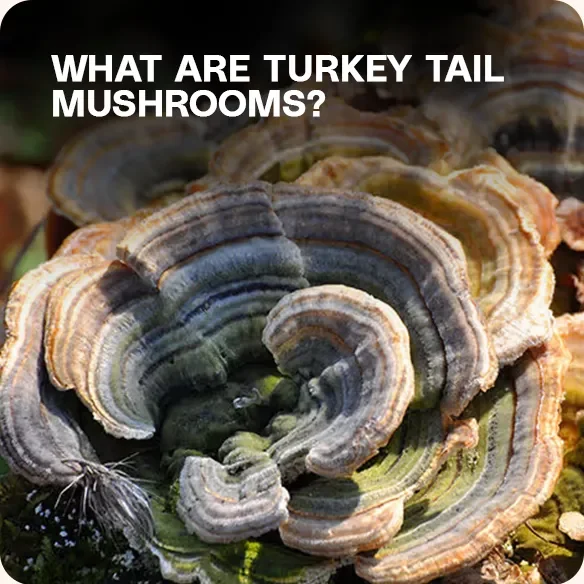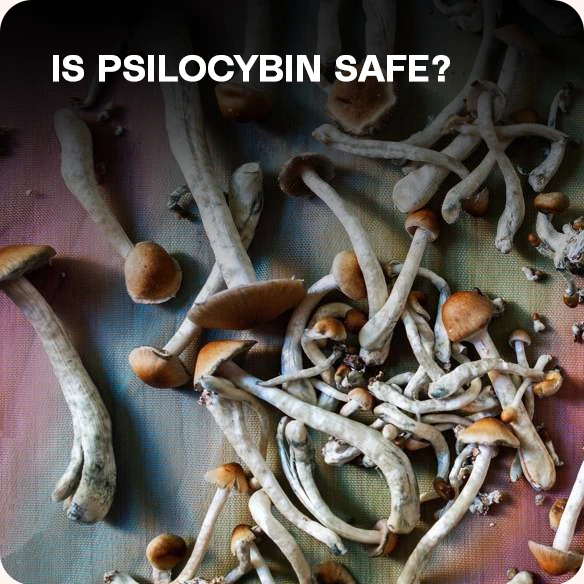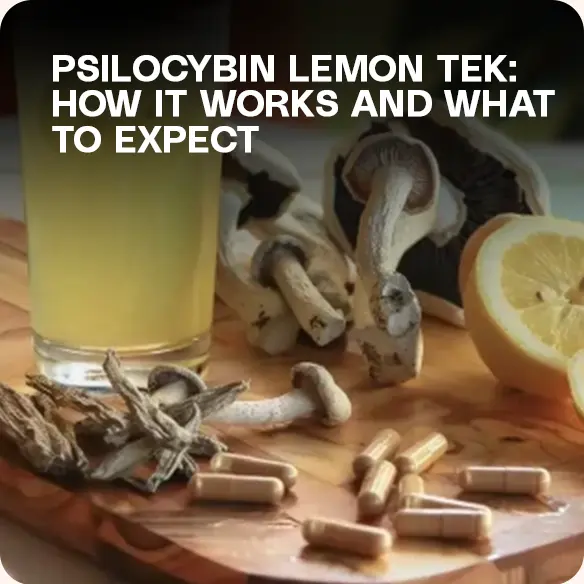Turkey Tail mushrooms (Trametes versicolor) are a type of polypore fungus that are widely known for their unique, fan-shaped appearance and colorful bands resembling the tail feathers of a turkey. They’re found growing on dead or decaying hardwood trees, and they can be spotted in forests around the world, especially in temperate regions.
You’ll often spot it growing on dead trees, logs, and stumps in damp forests. The thin, leathery caps form colorful bands of brown, gray, blue, green, and even purple.
While it’s not eaten for flavor—Turkey Tail is too tough for cooking—it has been used for centuries in teas, extracts, and supplements to support immune health and overall wellness.
Today, Turkey Tail mushrooms are widely studied and recommended in the health world for their potential benefits. Let’s explore what makes this mushroom so unique.
But that hasn’t stopped it from becoming one of the most talked-about mushrooms in health circles.
Let’s get into why.
What Are the Health Benefits of Turkey Tail Mushrooms?
Turkey Tail mushrooms (Trametes versicolor) provide powerful health benefits, especially for immune support, gut health, liver function, and antioxidant protection.
Used for centuries in traditional medicine, these functional mushrooms are now popular in modern wellness routines through teas, extracts, and supplements for long-term daily health.
- Immune Support
Turkey Tail is loaded with compounds called PSK and PSP. Doctors there have been using it since the 1970s to support cancer patients going through chemo. One study published in Cancer Immunology and Immunotherapy (Vol. 41, 1995) looked at over 260 colorectal cancer patients and found that those taking PSK had better survival rates than those who didn’t. - Antioxidant Power
Turkey Tail also contains a bunch of antioxidants—like flavonoids and phenols—that help your body deal with everyday stress and inflammation. - Gut Health
It’s got prebiotics, which are basically food for the good bacteria in your gut. - Liver Support
A 2017 study in Mycobiology tested a Turkey Tail extract on mice and found that it helped reduce liver damage caused by toxins like carbon tetrachloride. The researchers noticed less inflammation and better liver enzyme levels.
For immune system support beyond Turkey Tail’s benefits, Reishi mushroom offers additional adaptogenic properties
Are Turkey Tail Mushrooms Edible?
Yes, Turkey Tail mushrooms are edible, but that doesn’t mean you’ll want to chew on a handful. They’re tough, chewy, and feel more like biting into a dried leaf than an actual mushroom.
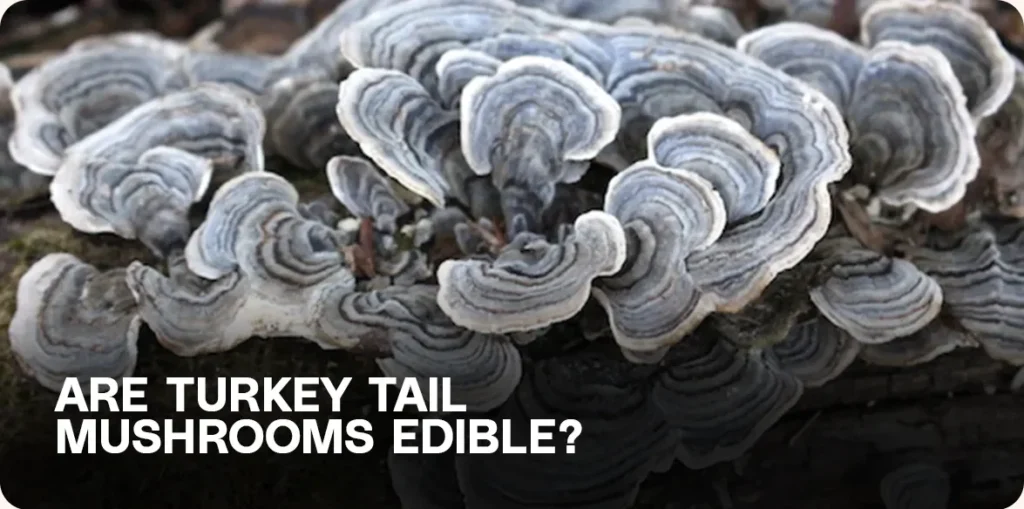
Most people say it tastes a little woody, a little bitter, and not something you’d want to toss in a stir-fry.
You can try eating them raw, but you’ll regret it about three chews in.
Cooking them doesn’t really help either—they stay rubbery no matter what you do.
That’s why most people don’t eat Turkey Tail the way they would other mushrooms.
How to Take Turkey Tail Mushrooms?
There are several easy ways to add Turkey Tail mushrooms to your daily routine—whether you prefer sipping tea, taking capsules, or blending powders. Here’s how:
- Turkey Tail Tea – The most popular method. Slice fresh or dried mushrooms and simmer in hot water for 15–30 minutes. Strain and sip for a soothing immune-boosting tea.
- Turkey Tail Extracts – Available as liquid drops or capsules. The simplest way to get consistent daily benefits without any prep or strong flavor.
- Turkey Tail Powder – Stir into smoothies, coffee, or hot drinks. The taste is earthy and strong, so it’s best mixed with other ingredients to balance the flavor.
So yeah, they’re edible, just not in the usual way.
Most people go with teas or supplements because they’re easier to take and you don’t have to chew through what feels like tree bark.
How Are Turkey Tail Mushrooms Different from Magic Mushrooms?
Turkey Tail mushrooms (Trametes versicolor) are non-psychedelic and used for immune support, gut health, and overall wellness.
Magic mushrooms contain psilocybin, a psychedelic compound that alters perception and mood.
In short—Turkey Tail is a functional mushroom for long-term health, while magic mushrooms are taken for their psychoactive effects.
One’s used for health, the other’s used to trip.
Do Turkey Tail Mushrooms Make You Trip?
No, Turkey Tail mushrooms won’t make you trip—not even a little.
They don’t contain psilocybin, which is the compound in magic mushrooms that causes hallucinations and other psychedelic effects.
You could drink Turkey Tail tea every day for a year and still not see colors swirl or hear your couch talk to you.
What’s the Difference in Compounds and Purpose?
Magic mushrooms, such as Psilocybe cubensis, contain psilocybin—a naturally occurring psychedelic compound. Psilocybin interacts with serotonin receptors in the brain, leading to altered perception, enhanced creativity, emotional breakthroughs, and spiritual experiences.
People often take magic mushrooms for self-reflection, emotional healing, or personal growth.
Turkey Tail mushrooms (Trametes versicolor) are completely different. They do not contain psilocybin or any psychedelic compounds. Instead, they are classified as functional mushrooms and are packed with health-supporting compounds like:
In short: magic mushrooms change your mind, Turkey Tail mushrooms support your body. You’re not getting a wild experience from Turkey Tail—you’re getting mushrooms that help with the slow, behind-the-scenes stuff.
Turkey Tail mushrooms are the kind you take when you’re trying to support your immune system. Magic mushrooms are the kind you take when you want to have a psychedelic trip.
These two get mixed up because they’re both mushrooms, but that’s pretty much where the similarities stop.
Turkey Tail doesn’t contain psilocybin, which is the compound in magic mushrooms that makes you trip.
So, if you’re thinking you’ll get visuals or any sort of high from Turkey Tail, you’re going to be disappointed. These mushrooms are more about long-term health than wild trips.
Magic mushrooms, on the other hand, are in a whole different category. They’re used for things like introspection, creativity, or just riding out a full-blown trip. Turkey Tail is used for gut health, immune support, and general wellness. One’s closer to a supplement, the other’s a psychedelic.
Where Do Turkey Tail Mushrooms Grow?
Turkey Tail mushrooms grow straight out of dead wood: logs, stumps, broken branches, etc. They’re all over the place once you know how to spot them.
What Environments Do They Thrive In?
They like it cool, damp, and shady. You’ll mostly find them in:
- Forests after it rains
- Wooded parks and trails
- Anywhere trees are left to rot naturally
If it’s wet, quiet, and there’s some dead wood lying around, that’s Turkey Tail country.
Are Turkey Tail Mushrooms Easy to Find in the Wild?
Yes and no. They’re everywhere, but they blend in so well that you’ve probably walked past them a dozen times.
Once you know what to look for—thin, wavy layers stacked like roof shingles, with stripes of brown, gray, blue, or green—you’ll start noticing them constantly.
What Types of Trees or Wood Do They Grow On?
Mostly hardwoods like oak, beech, and maple. But they’re not picky. They’ll grow on:
- Fallen logs
- Rotting stumps
- Dead branches
- Occasionally on conifers, but that’s less common
If it’s dead, damp, and made of wood, Turkey Tail might be growing on it. You just have to slow down and check.
How Can You Identify Turkey Tail Mushrooms?
Look for thin, fan-shaped mushrooms growing on dead wood, with colorful concentric bands on top and tiny white pores underneath.
Turkey Tail mushrooms are one of those mushrooms you don’t notice until you learn what they look like—and then suddenly, they’re everywhere.
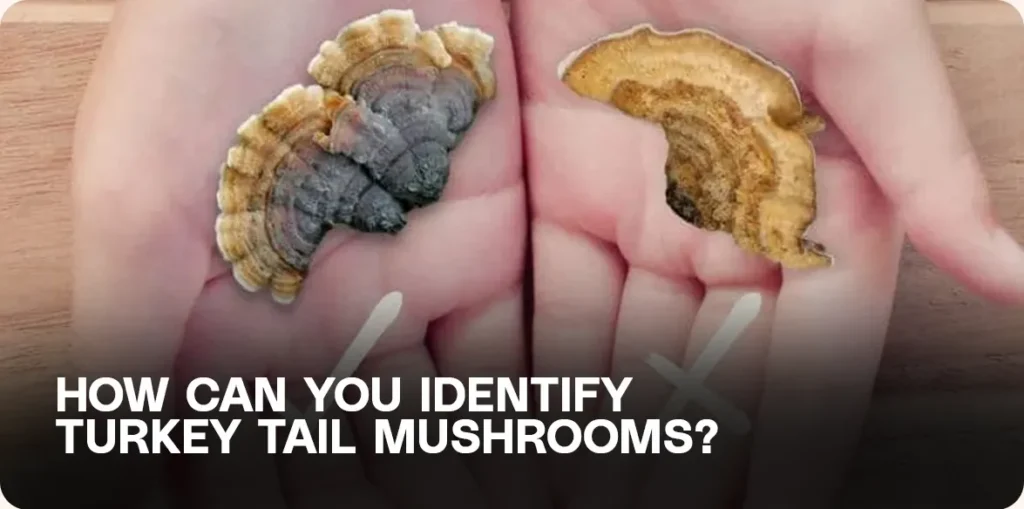
They grow in stacks, they cling to dead wood, and they’ve got one of the most recognizable patterns in the mushroom world. But yeah, you still need to know what you’re looking for.
What Colors and Patterns Should You Look For?
The caps grow in thin, fan-like layers, and the surface has stripes that look like feathers. You’ll usually see:
- Shades of brown, gray, tan, white, blue, and sometimes green if moss starts growing on them
- Concentric bands that follow the shape of the cap
- A velvety or fuzzy texture when they’re fresh
If it looks like a small mushroom that resembles a turkey’s tail fan, that’s probably it.
What Is Their Size, Shape, and Texture?
- Size: Small and thin—usually 1 to 4 inches across
- Shape: Fan-shaped or shell-like, almost like roof tiles layered over each other
- Texture: Dry, leathery, and flexible when fresh; tough and papery when dried out
How Do You Confirm It’s the Real Turkey Tail Mushroom?
Flip it over. The underside of a true Turkey Tail has tiny white or off-white pores, not gills.
That’s the giveaway. If the bottom has pores and the top has those signature rings, you’re probably holding the real thing.
You can also look for the scientific name: Trametes versicolor. The “versicolor” part means “many colors,” which fits perfectly.
Are There Any Dangerous Mushroom Look-Alikes?
Yes, and this part’s important. There are a few mushrooms that look like Turkey Tail but aren’t. The most common one is False Turkey Tail (Stereum ostrea). Here’s how to tell the difference:
- False Turkey Tail has no pores underneath. It’s smooth on the bottom.
- It also tends to be thinner and shinier on top.
False Turkey Tail isn’t toxic, but it doesn’t have the same benefits either. So if you’re foraging, always check the underside before tossing anything into your basket.
Can You Grow Turkey Tail Mushrooms at Home?
Yes, you can grow Turkey Tail mushrooms at home, but these mushrooms grow on wood, not soil, and they take a bit more patience. But if you’ve got the right setup, you can definitely pull it off.
What’s Everything You Need?
Here’s the basics:
- Turkey Tail spawn or spores
You’ll need to get either a liquid culture, spore syringe, or pre-colonized spawn. Most people go with grain spawn—it’s easier and faster. - Hardwood sawdust or wood chips
Turkey Tail grows on hardwood, not straw or manure like other mushrooms. Oak, maple, or beech chips work best. You can buy hardwood pellets or sawdust blocks if you don’t want to mess with woodchips. - Containers or grow bags
You can use filter patch grow bags or even buckets with holes drilled in the sides. Just make sure whatever you use lets the mushrooms breathe while keeping out contamination. - Pressure cooker or sterilizer
Since you’re dealing with wood, you need to sterilize the substrate—pasteurization won’t cut it. A pressure cooker is a must. - Clean workspace
Contamination is no joke with Turkey Tail. Make sure you’re working in a clean area, and always sterilize your tools. - Humidity and airflow
Once colonized, Turkey Tail needs high humidity (around 85–95%) and some fresh air. A grow tent or shotgun fruiting chamber can help if you’re indoors.
Turkey Tail isn’t a fast grower. It can take a few months from start to finish. But once it’s going, it fruits for a long time—sometimes with multiple flushes over several weeks.
So yeah, it’s more work than your average mushroom grow, but if you’re into slow and steady, this one’s worth the effort.
When and How Do You Harvest Turkey Tail Mushrooms?
Turkey tail isn’t one of those mushrooms you pick and eat on the same day, it grows slowly. But there are a few easy ways to tell when it’s good to go.
How Do You Know When They’re Ready?
You don’t need a microscope or lab gear—just pay attention:
- They’ve stopped growing.
If they look the same size every time you check, they’re done. No more waiting. - They still feel a little flexible.
You want them leathery but not bone-dry. If they crack when you bend them, you probably waited too long. - The color’s still sharp.
You’re looking for those bold bands of brown, gray, or blue. If everything’s faded and dull, skip it—it’s past its prime.
What’s the Best Way to Pick and Preserve Turkey Tail Mushrooms?
You don’t need to rip them off the log like you’re in a hurry.
- Use a pocketknife. Slide it under the base and pop them off clean. Don’t go hacking at the whole cluster.
- Skip the rinse. Wipe off any dirt or bugs with your hands or a soft brush. Turkey Tail doesn’t like water once it’s off the wood.
- Dry them fast. Throw them on a drying rack with a fan or use a dehydrator. You want them crispy, not chewy.
- Store them right. Once they’re fully dry, toss them in a jar with a silica packet or vacuum-seal them. Keep it cool and dark.
Done right, they’ll stay good for months. Maybe longer. It’s not complicated—you just have to know when to act and not leave them out there until they’re a piece of bark.
Can You Microdose Turkey Tail Mushrooms?
Yes, but it’s not the same kind of microdosing you hear about with magic mushrooms.
Turkey Tail doesn’t contain psilocybin, so you’re not going to feel any creativity or focus.
People usually take 500mg to 1g per day, depending on the form. Some use capsules, others stir the powder into tea, coffee, or smoothies. You don’t feel anything right away—it’s more of a long-term thing.
How Is It Different from Microdosing Psilocybin?
Totally different.
- Psilocybin microdosing is about improving mood, focus, or creativity in tiny amounts without tripping.
- Turkey Tail microdosing is more like taking a vitamin—it’s about overall health, not changing your state of mind.
One affects your brain. The other supports your body. They might both come from mushrooms, but the goals are completely different.
Why Take Turkey Tail Mushrooms?
Turkey Tail mushrooms are one of the most trusted functional mushrooms for daily wellness. Backed by research for immune system support, gut health, and antioxidant effects, they fit easily into modern routines as teas, powders, or supplements.
Whether you’re foraging in the wild or adding Turkey Tail extracts to your diet, this mushroom offers long-term health benefits without psychoactive effects.
FAQ
Is Turkey Tail mushroom psychedelic?
No, Turkey Tail mushrooms do not contain psilocybin or any psychedelic compounds. They are considered functional mushrooms used for immune support and general health.
Does Turkey Tail mushroom get you high?
No. Turkey Tail mushrooms will not make you high. They do not have psychoactive effects and are used as dietary supplements, often in teas or extracts.
Can I take Turkey Tail mushrooms before bed?
Yes, you can take Turkey Tail mushrooms before bed. They do not cause stimulation or psychoactive effects, and some people include them in their evening routine to support immune health and relaxation.
